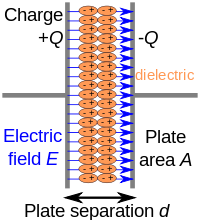
Photo from wikipedia
We adopt an analytical approach to study the dielectric relaxation and ac conductivity behavior of the polyvinyl alcohol (PVA) - Cadmium Selenide (CdSe) nanocomposite films in the frequency range 100… Click to show full abstract
We adopt an analytical approach to study the dielectric relaxation and ac conductivity behavior of the polyvinyl alcohol (PVA) - Cadmium Selenide (CdSe) nanocomposite films in the frequency range 100 Hz ≤ f ≤ 1 MHz and in the temperature range 298 K ≤ T ≤ 420 K. The CdSe nanoparticles are synthesized via a simple wet chemical route and are then impregnated into the polyvinyl alcohol matrix by 0.5 wt%, 1 wt%, and 4 wt%. About 1.7 times increase in effective permittivity (at 100 KHz) for the 4 wt% nanoparticle impregnated sample is observed from the analysis of the dielectric reinforcement function, which is attributed to the occurrence of interfacial polarization. It is found that the Cole-Cole model with a dc conductivity correction term can well fit the permittivity data. We have found that the dielectric relaxation time increases with increase in nanoinclusion into the matrix but decreases with increase in temperature. However, the space charge carrier conductivity and free charge carrier conductivity increase either with increase in nano inclusions or with increase in temperature. AC conductivity behavior have been analyzed considering the Jonscher power law and Dyre's random free energy barrier model, which reveals lowering of the maximum barrier height and correlated barrier hopping as the prevalent charge transport mechanism for the nanocomposites. Electric modulus study indicates similar conductivity relaxation dynamics for the nanocomposites but the responses deviate appreciably from the simulated ideal Debye responses. POLYM. COMPOS., 2015. © 2015 Society of Plastics Engineers
Journal Title: Polymer Composites
Year Published: 2017
Link to full text (if available)
Share on Social Media: Sign Up to like & get
recommendations!